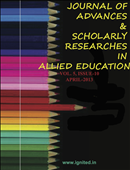Study on Hypergraphs and Directed Hypergraphs
DOI:
https://doi.org/10.29070/qpbd9y90Keywords:
hypergraphs, directed hypergraphs, graph theory, transportation planning, logic, artificial intelligence, biological networks analysis, protein interactions, modelling paradigm, tram linesAbstract
A graph is often thought of as an abstract structure that represents the pairwise connections between collections of objects known as vertices. Two vertices may be linked by an edge or can exist independently of one another. Allowing an edge to link an arbitrary number of vertices is one method to broaden this notion. Hyperedges are subsets of the vertex set, and they are referred to as such. A hypergraph is made up of a set of vertices and a family of hyperedges. Hypergraphs are more abstract than graphs, having less structure. Hypergraphs, rather than graphs, are better suited as a modelling paradigm in certain situations. Hypergraphs are used to simulate tram lines in [Karbstein, 2012]) and railway vehicle coupling in [Borndörfer et al., 2012] in the area of transportation planning. See [Eiter and Gottlob, 1995] for examples of hypergraphs in the fields of logic and artificial intelligence. In addition, both directed and undirected hypergraphs are effectively employed in the area of biological networks analysis for a brief review, see [Klamt et al., 2009]. Protein interactions, for example, often include more than one protein, therefore hyperedges rather than edges may be utilised to simulate them more correctly.References
Chirs Cornelis, Gad Deschrijver, Mike Nachtegael, Steven Schockaert and Yun Shi (Eds.), 35 years of fuzzy set theory, Springer-Verlag, Berlin Heidelberg, 2010.
Daniele Pretolani, A directed hyper-graph model for random time dependent shortest paths, European Journal of Operational Research, 123 (2), 2000, 315 - 324.
G.Bortolan and R. Degani, A review of some methods for ranking fuzzy subsets, Fuzzy Sets and Systems, 15 (1), 1985, 1 - 19.
H. Bustine and P. Burillo, Vague sets are intuitionistic fuzzy sets, Fuzzy Sets and Systems, 79 (3), 1996, 403 - 405.
K. R. Bhutani and A. Rosenfeld, Fuzzy end nodes in fuzzy graphs, Information Sciences, 152, 2003, 323 - 326.
K. R. Bhutani and A. Rosenfeld, Strong arcs in fuzzy graphs, Information Sciences, 152, 2003, 319 - 322.
K. R. Bhutani, On auto-morphisms of fuzzy graphs, Pattern recognition letters, 9 (3), 1989, 159 - 162.
M. Brinkmeier, J. Werner and S. Recknagel, Communities in graphs and hyper-graphs, Proceedings of the 16TH ACM conference on Conference on In-formation and Knowledge Management, 2007, 869 - 872.
P. Bhattacharya and F. Suraweera, An Algorithm to compute the max-min powers and a property of fuzzy graphs, Patteren Recognition Letters, 12 (7), 1991, 413 - 420.
P. Bhattacharya, Some remarks on fuzzy graphs, Patteren Recognition Let-ters, 6 (5), 1987, 297 - 302.
P. Burillo, H. Bustince and V. Mohedano, Some definitions of intuitionistic fuzzy number, Proceedings of the 1ST Workshop on Fuzzy Based Expert Systems, D. Lakov, Ed., Sofia, Bulgaria, September 1994, 53 - 55.
S. Chawla, J. Davis and G. Pandy, On local pruning of association rules using directed hyper-graphs, ICDE’04 - Proceedings of the 20TH IEEE International Conference on Data Engineering, 2004, 832.
S. Chen, Ranking fuzzy numbers with maximizing set and minimizing set, Fuzzy Sets and Systems, 17 (2), 1985, 113 - 129.
W. Chang, Ranking of fuzzy utilities with triangular membership functions, Proceedings of the International Conference on Policy Analysis and Information Systems, 1981, 263 - 272.











